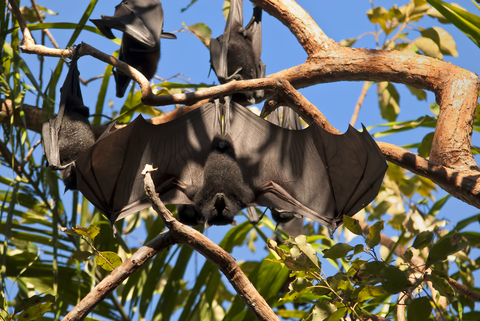
Some species of bats in Australia carry the Australian bat lyssavirus (ABLV), which is closely related (but not identical) to the rabies virus. Like rabies, it can be transmitted to humans via the mammals’ saliva through a bite, a scratch, an open wound or mucous membrane (eyes, mouth, nose) and produces symptoms that include paralysis, delirium and convulsions, followed by death if the prescribed treatment is not administered. To date there have been three cases of ABLV disease in Australians following a bite or scratch from infected bats, sadly all of which were fatal.
Where it is found
ABLV has been detected among all four species of flying foxes/fruit bats and in one species of insect-eating microbats in Australia, with serological evidence suggesting a wide geographical distribution across all states and territories. All bats however are presumed to have the potential to carry ABLV.
Prevention: Do. Not. Touch. Bats.
Don’t approach or attempt any contact with bats. The advice is to avoid handling any bat in Australia, or overseas - and the same applies for wild or domestic mammals in countries with endemic rabies.
Anyone coming across an injured bat in Australia should not approach it, but contact the Department of Environment and Science (1300 130 372), RSPCA (1300 ANIMAL) or local wildlife care groups/rescuers/carers for assistance. Healthy bats should also be avoided and ensure that any children know this too.
Rabies/ABLV is a vaccine-preventable disease with options for pre-exposure and post-exposure management of risk.
Pre-exposure vaccinations pertaining to bat exposure are generally only recommended for the following groups:
- Travellers planning outdoor activities with risk of exposure to bats - such as caving.
- People planning to work with or around bats – researchers, wildlife workers, park rangers.
Post-exposure vaccinations are part of the treatment regimen needed (with some urgency) in the event of an at-risk exposure. (See more under PEP below)
Who is at risk?
Individuals who handle bats in Australia are at risk of ABLV infection, as is anyone who is accidentally bitten, licked or scratched by a bat.
Individuals travelling overseas should discuss with their travel health provider whether rabies vaccinations are recommended for their itinerary, taking into account the destination, duration of stay and activities planned, amongst other factors. Read more on Rabies.
Suspected exposure to Lyssavirus:
All of these steps need to be taken immediately and in the right order in case of suspected exposure to bats/bat saliva.
- First response: cleanse the wound thoroughly with lots of soap and water for at least 15 minutes. The wound should not be scrubbed as the aim is to remove the virus contained in saliva without further damaging the tissue. Cleaning the wound may prevent infection, but is no guarantee.
- Next: if available, apply an antiseptic with antivirus actions such as povidone-iodine, iodine or aqueous iodine to the wound. Don’t bind the wound tightly – just cover it with gauze to prevent secondary infection or leave it uncovered. Tetanus and other wound infections should also be taken into consideration.
- Finally (critically), seek expert medical attention as a matter of urgency to begin the post exposure vaccination regime.
Rabies vaccination
NB: Even if you have previously received the rabies pre-exposure vaccination course (see PrEP below), booster doses - and first aid measures - are still required if exposed to the Australian bat lyssavirus.
VACCINATION:
Type: Injection
- Human rabies immunoglobulin (HRIG) - made from components of the blood donated by people who have been vaccinated against rabies. It contains a concentrated form of antibodies which neutralise the rabies virus. HRIG is injected around the site of exposure.
- Rabies inactivated virus vaccines - given as an injection (usually intramuscular); it stimulates the immune system so a person develops their own rabies antibodies to neutralise the virus.
VACCINATION SCHEDULES:
Pre-exposure vaccination (PrEP):
Generally only recommended if you will be at risk of exposure to bats during activities or work. A course of 3 rabies vaccines given over one month (days 0, 7 and 21 or 28).
Post-exposure vaccination (PEP):
This applies if you have not had the pre-exposure rabies vaccine course:
1 weight-dependent dose of HRIG and 4 doses of rabies vaccine over 14 days (days 0, 3, 7, 14) – HRIG must be given within 7 days of starting the vaccine doses.
For those who have had the pre-exposure course:
2 additional doses of rabies vaccine over 3 days (day 0, 3) – no HRIG required.
Post-exposure vaccination is recommended regardless of how long ago the exposure occurred.
Ongoing risk:
If there is an ongoing high risk of exposure, such as in a laboratory worker or bat handlers, a blood test checking rabies antibody levels every 2 years will determine if a booster dose is required.
Finally:
ABLV exposures, although rare, and this includes any bat exposure (i.e. bite, scratch, or lick on exposed mucous membranes) require urgent assessment and consideration for ABLV post-exposure management. ABLV is a notifiable disease and the local state/territory public health unit can provide advice on the necessary treatment, as well as provide HRIG and vaccines are necessary.
More indepth information on Rabies can be found under the Resources tab.
